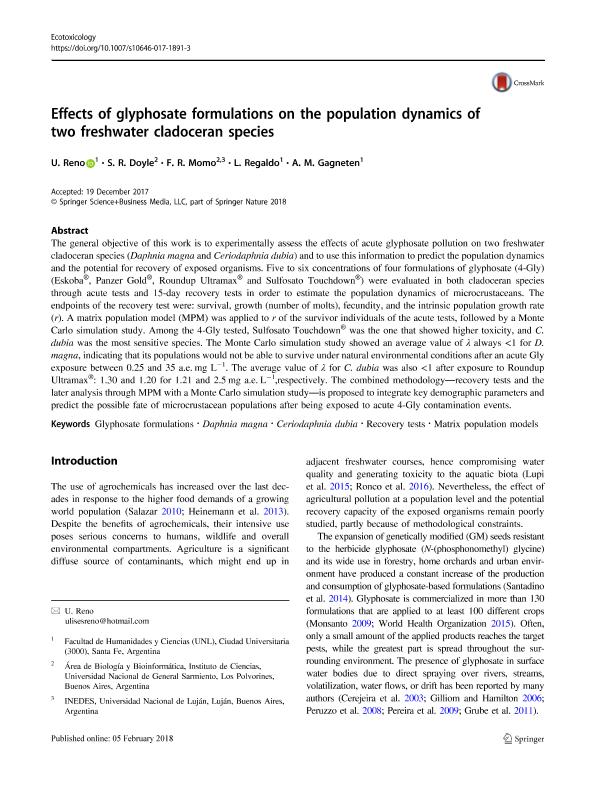Artículo
Effects of glyphosate formulations on the population dynamics of two freshwater cladoceran species
Reno, Ulises ; Doyle, Santiago Raúl
; Doyle, Santiago Raúl ; Momo, Fernando Roberto; Regaldo, Luciana María
; Momo, Fernando Roberto; Regaldo, Luciana María ; Gagneten, Ana María
; Gagneten, Ana María
 ; Doyle, Santiago Raúl
; Doyle, Santiago Raúl ; Momo, Fernando Roberto; Regaldo, Luciana María
; Momo, Fernando Roberto; Regaldo, Luciana María ; Gagneten, Ana María
; Gagneten, Ana María
Fecha de publicación:
09/2018
Editorial:
Springer
Revista:
Ecotoxicology
ISSN:
0963-9292
e-ISSN:
1573-3017
Idioma:
Inglés
Tipo de recurso:
Artículo publicado
Clasificación temática:
Resumen
The general objective of this work is to experimentally assess the effects of acute glyphosate pollution on two freshwater cladoceran species (Daphnia magna and Ceriodaphnia dubia) and to use this information to predict the population dynamics and the potential for recovery of exposed organisms. Five to six concentrations of four formulations of glyphosate (4-Gly) (Eskoba®, Panzer Gold®, Roundup Ultramax® and Sulfosato Touchdown®) were evaluated in both cladoceran species through acute tests and 15-day recovery tests in order to estimate the population dynamics of microcrustaceans. The endpoints of the recovery test were: survival, growth (number of molts), fecundity, and the intrinsic population growth rate (r). A matrix population model (MPM) was applied to r of the survivor individuals of the acute tests, followed by a Monte Carlo simulation study. Among the 4-Gly tested, Sulfosato Touchdown® was the one that showed higher toxicity, and C. dubia was the most sensitive species. The Monte Carlo simulation study showed an average value of λ always <1 for D. magna, indicating that its populations would not be able to survive under natural environmental conditions after an acute Gly exposure between 0.25 and 35 a.e. mg L−1. The average value of λ for C. dubia was also <1 after exposure to Roundup Ultramax®: 1.30 and 1.20 for 1.21 and 2.5 mg a.e. L−1,respectively. The combined methodology—recovery tests and the later analysis through MPM with a Monte Carlo simulation study—is proposed to integrate key demographic parameters and predict the possible fate of microcrustacean populations after being exposed to acute 4-Gly contamination events.
Archivos asociados
Licencia
Identificadores
Colecciones
Articulos(CCT - SANTA FE)
Articulos de CTRO.CIENTIFICO TECNOL.CONICET - SANTA FE
Articulos de CTRO.CIENTIFICO TECNOL.CONICET - SANTA FE
Citación
Reno, Ulises; Doyle, Santiago Raúl; Momo, Fernando Roberto; Regaldo, Luciana María; Gagneten, Ana María; Effects of glyphosate formulations on the population dynamics of two freshwater cladoceran species; Springer; Ecotoxicology; 27; 7; 9-2018; 784-793
Compartir
Altmétricas



